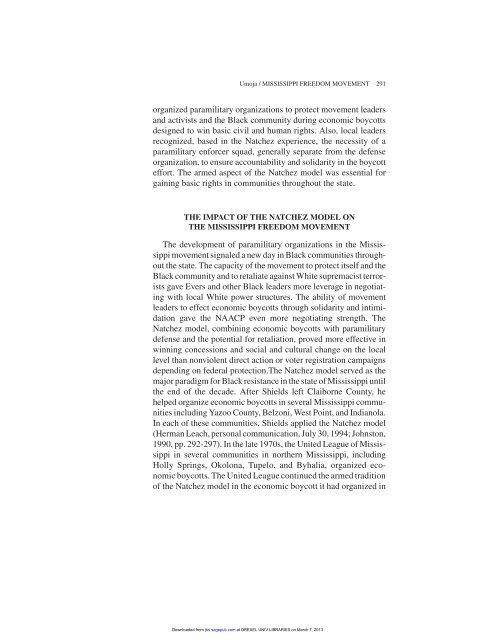MXGM Self-Defence Manual
MXGM Self-Defence Manual
MXGM Self-Defence Manual
Create successful ePaper yourself
Turn your PDF publications into a flip-book with our unique Google optimized e-Paper software.
Umoja / MISSISSIPPI FREEDOM MOVEMENT 291<br />
organized paramilitary organizations to protect movement leaders<br />
and activists and the Black community during economic boycotts<br />
designed to win basic civil and human rights. Also, local leaders<br />
recognized, based in the Natchez experience, the necessity of a<br />
paramilitary enforcer squad, generally separate from the defense<br />
organization, to ensure accountability and solidarity in the boycott<br />
effort. The armed aspect of the Natchez model was essential for<br />
gaining basic rights in communities throughout the state.<br />
THE IMPACT OF THE NATCHEZ MODEL ON<br />
THE MISSISSIPPI FREEDOM MOVEMENT<br />
The development of paramilitary organizations in the Mississippi<br />
movement signaled a new day in Black communities throughout<br />
the state. The capacity of the movement to protect itself and the<br />
Black community and to retaliate against White supremacist terrorists<br />
gave Evers and other Black leaders more leverage in negotiating<br />
with local White power structures. The ability of movement<br />
leaders to effect economic boycotts through solidarity and intimidation<br />
gave the NAACP even more negotiating strength. The<br />
Natchez model, combining economic boycotts with paramilitary<br />
defense and the potential for retaliation, proved more effective in<br />
winning concessions and social and cultural change on the local<br />
level than nonviolent direct action or voter registration campaigns<br />
depending on federal protection.The Natchez model served as the<br />
major paradigm for Black resistance in the state of Mississippi until<br />
the end of the decade. After Shields left Claiborne County, he<br />
helped organize economic boycotts in several Mississippi communities<br />
including Yazoo County, Belzoni, West Point, and Indianola.<br />
In each of these communities, Shields applied the Natchez model<br />
(Herman Leach, personal communication, July 30, 1994; Johnston,<br />
1990, pp. 292-297). In the late 1970s, the United League of Mississippi<br />
in several communities in northern Mississippi, including<br />
Holly Springs, Okolona, Tupelo, and Byhalia, organized economic<br />
boycotts. The United League continued the armed tradition<br />
of the Natchez model in the economic boycott it had organized in<br />
Downloaded from jbs.sagepub.com at DREXEL UNIV LIBRARIES on March 7, 2013


